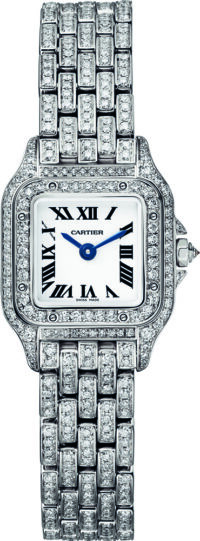The legendary Santos de Cartier is back on the scene, ready to take off for another century of elegance. One model, three versions … and an abundance of new features. The Santos de Cartier has not aged in the slightest.
By Olivier Müller
Historic inaccuracies are long-lived. It is often said that Cartier invented the pilot’s watch. But that is not strictly true: Cartier was there even earlier than that! In 1904, when the house designed its initial wristwatch for Alberto Santos-Dumont, aviation did not really exist. The term ‘flying machines’ was used rather than aircraft. The era of aerostats had almost arrived. The wristwatch itself was almost non-existent, before military usage in the First World War changed conventions.
The airborne elegance of a flying man
The Santos de Cartier represents a page of history. It is the watch of a man who saw beyond the horizon, a man who devised more than 22 flying machines, put his life in danger with each new flight and invented a wardrobe to match his own impressive stature. Alberto Santos-Dumont was also Louis Cartier’s friend. Their respective visions were complementary, and merged together in the watch that was to become the ‘Santos de Cartier’. All, or almost all, of contemporary watchmaking was already present in the Santos de Cartier. It was a unique model, the crowning achievement of a talented high-jewellery house turned master watchmaker. It was worn on the wrist so the wearer could tell the time while flying – a revolution! It was eminently modern, its visible screws evoking the mechanical beauty of Alberto Santos-Dumont’s flying prototypes. It was timeless and unfettered by passing trends, shaped like a square with rounded corners in an age when pocket watches were invariably round. Like modern aviation, ‘watch design’ did not yet exist, but together Louis Cartier and Alberto Santos-Dumont were to lay down its foundations.

Established
1847
Company status
Société anonyme (public limited company) of the Richemont group
Senior Management
Cyrille Vigneron, CEO and President of Cartier International
Number of employees
7,000
Flagship collections
Ballon Bleu, Santos, Tank
Bestseller
Ballon Bleu de Cartier
Retail prices
From CHF 2,300
Annual production
Undisclosed
The return of a legend
More than a century later, the Cartier manufacture has paid tribute to this timepiece. It is available with three different versions of the case (gold, steel and gold-steel) and is embellished with the house’s flagship features: Roman numerals, blued-steel hands, and a beaded crown with blue cabochon. Visible screws are dotted around the bezel of the famous rounded square case, just like the original creation from 1904. It presents the Parisian geometrical style of the time – streamlined and symmetrical, recalling the powerful architecture of the Eiffel Tower, which was completed 15 years earlier. The new Santos de Cartier comes with three hands, as a chronograph or skeleton watch, in a small or large version, and with a leather strap or steel bracelet. It is no longer necessary to choose: the straps/bracelets are interchangeable thanks to the patented QuickSwitch system. They merge with the case and can be changed without any tools. The bracelets can also be adjusted to the closest link thanks to the SmartLink system, which has also been patented. Lastly, this iconic watch incorporates other modern breakthroughs: the quartz version, for example, has a new, very-high-autonomy movement offering six years of battery life.
The Panthère leaves its mark once more
The panther is the emblematic Cartier animal. It also alludes to the Panthère de Cartier watch collection, which has been embracing women’s wrists with feline elegance for the last 15 years. In the latest collection, the timepiece is transformed into a cuff watch. The dial is positioned off-centre and the bracelet covers a wide area, as silky and supple as the feline’s fur. Transformed into jewellery, the Panthère de Cartier graces the wrist with gold links, diamonds or lacquer. In addition to these cuff watches, Cartier has also unveiled a mini Panthère watch. In yellow, rose or white gold as well as steel, it adorns the wrist with a single-, double- or triple-loop strap, perfecting the style of the Cartier woman with a chic and casual bracelet that reveals the skin, subtle and sensual, between two golden links.

Baignoire watch in yellow gold with quartz movement and taupe alligator-leather strap.
Cartier dives in at the deep end
Oval or ellipse? The choice is Baignoire, or bath: Cartier, the sculptor of forms, does not allow itself to be so easily defined by words, however aesthetic they may be. Originally designed in 1912 by Louis Cartier himself, the modern Baignoire watch owes much to its 1958 predecessor, which displays a narrower strap, redesigned Roman numerals against a sand-blasted silvered background, and a new case back perfectly suited to the volume of the case, which is water-resistant to 30 metres. This resurgence was accompanied by a second model in the 1960s: the Baignoire Allongée. Its stretched-out form appealed for its confident disproportion. Its curves embrace the shape of the wrist with an impertinence that is emphasised by a stream of diamonds flowing over the bezel, the dial and even the entire bracelet. It is a Baignoire model brimming with joy and boldness, whose simplicity dissimulates its extreme sophistication and perfectly mastered proportions.





